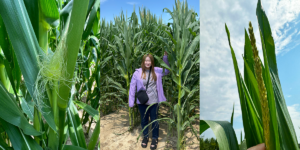To help increase awareness about sustainable agriculture production, Bio Huma Netics, Inc., (BHN) is sponsoring a FarmProgress course for Certified Crop Advisers (CCAs) and Pest Control Advisers (PCAs) in the United States and Canada.
This free online continuing education course, titled “Organic/Sustainable Agriculture Production -2022” aims to help working professionals learn about sustainable farming practices and pest management without the use of synthetic chemicals.
During the training, participants will learn about most common pests in organic/sustainable agricultural systems and current methods of controlling insect pests, weeds, and diseases in a range of organic crops grown in the United States.
The two-hour duration course is divided into ten sections and allows participants to complete it at their own pace.
Course Structure
Section 1: Introduction
Section 2: Organic Agriculture
Sustainable / Organic Management Options for Major Insects and Diseases of:
Section 3: Citrus
Section 4: Grapes
Section 5: Pome Fruit
Section 6: Blueberries and Strawberries
Section 7: Stone Fruit
Section 8: Nut Trees
Section 9: Vegetable Crops
Section 10: Forage Crops
“Pest management is an integral part of conventional and organic farming and requires adequate training. At times, managing pests in organic farming systems is much more challenging because of fewer options than in conventional production. By taking this course, participants can learn how to identify and combat pest infestation to minimize crop damage under organic cultural practices,” says Dr. Mojtaba Zaifnejad, Sr. Director of Field Research and Technical Services, BHN. In addition, this course provides a brief insight on how humic substances can benefit the health of soil and crops.
To enroll, or to learn more about the course, visit AgCEUOnline.
Related Posts

How Advances in Crop Genetics Influence Nutrient Management
Advances in crop genetics are transforming how farmers approach nutrient management. Improved seed resilience, higher yield potential, and changing plant behaviors mean that fertility programs must evolve too. As genetics drive progress across the farm, understanding how nutrition supports those genetics is key to maximizing productivity and sustainability

Celebrating the Life of Jason Garcia
We lost Jason Garcia this week, his life cut short way too soon. When Jason joined BHN as an agronomist in 2019, it was apparent early on that we had hired a special guy. Jason was ENTHUSIASTIC! Always. You just couldn’t have a conversation with Jason without hearing a great story about someone in his

This Week in Ag #21
You’ve all heard the saying “knee-high by the fourth of July” to describe the progress of a corn crop. It’s a phrase many folks still refer to today. But as the photo below shows, that saying is now laughable. In fact, if you’re a Midwest farmer and your corn is now knee high, it’s probably in big

